Page 75 of 354
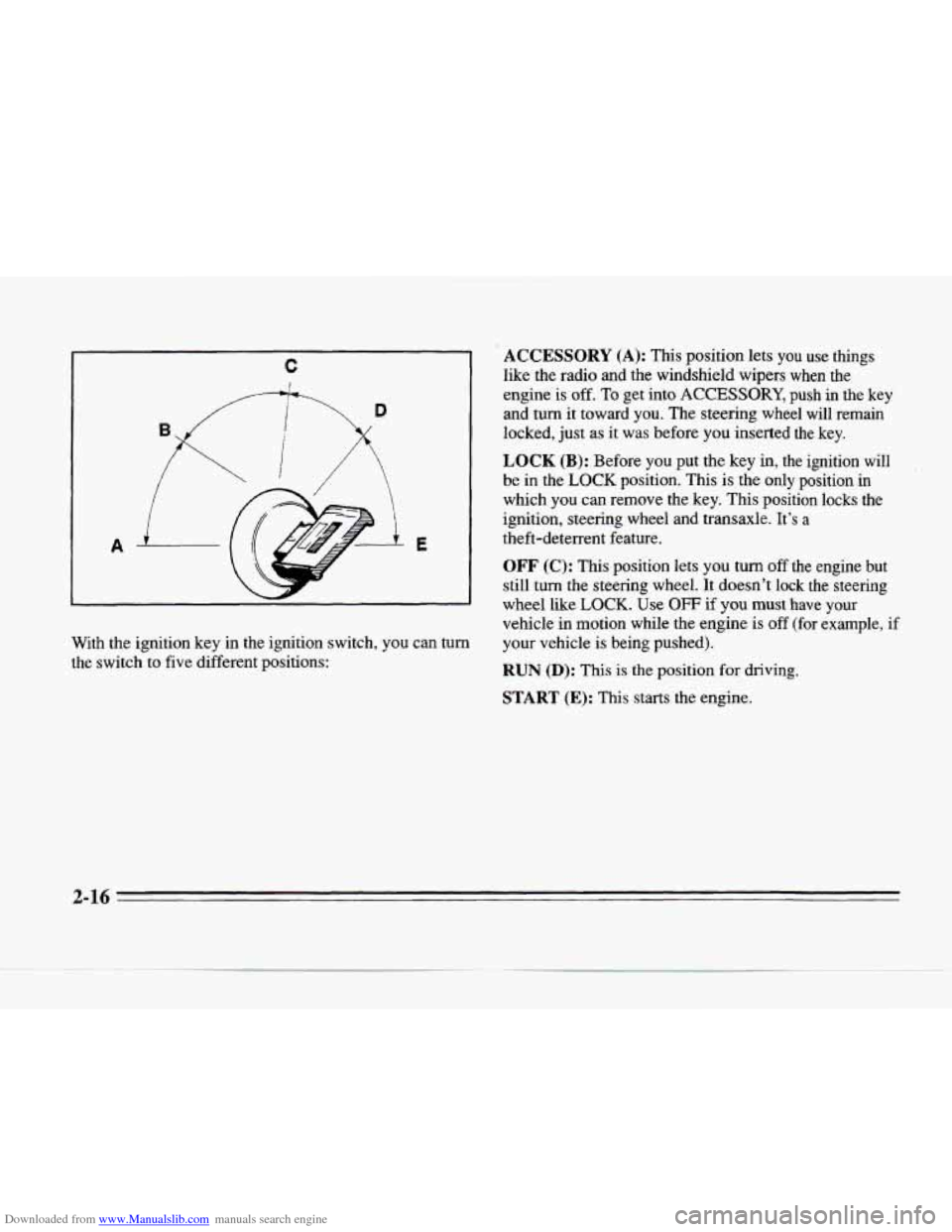
Downloaded from www.Manualslib.com manuals search engine C
I
W
With the ignition key in the ignition switch, you can turn
the switch to five different positions:
ACCESSORY (A): This position lets you use things
like the radio and the windshield wipers when the
engine is
off. To get into ACCESSORY, push in the key
and turn it toward you. The steering wheel will remain
locked, just as it was before you inserted the key.
LOCK (B): Before you put the key in, the ignition will
be in the LOCK position. This is the only position in
which you can remove the key. This position locks the
ignition, steering wheel and transaxle. It’s a
theft-deterrent feature.
OFF (C): This position lets you turn off the engine but
still turn the steering wheel.
It doesn’t lock the steering
wheel like
LOCK. Use OFF if you must have your
vehicle in motion while the engine is off (for example, if
your vehicle is being pushed).
RUN (D): This is the position for driving.
START (E): This starts the engine.
2-16
4
Page 80 of 354
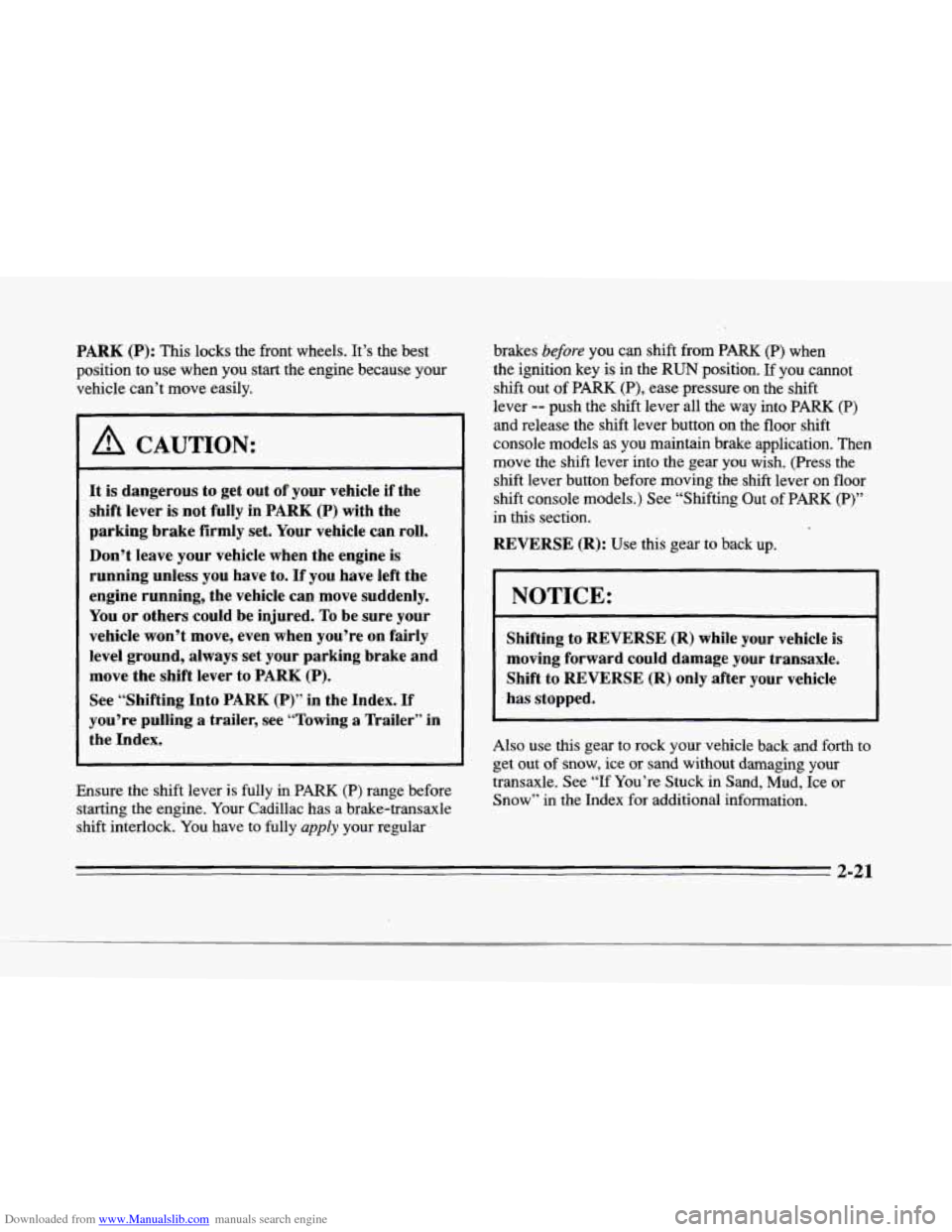
Downloaded from www.Manualslib.com manuals search engine r
I’
i
r“.
f
r.
r
PARK (P): This locks the front wheels. It’s the best
position to use when you start the engine because your
vehicle can’t move easily.
I A CAUTION:
It is dangerous to get out of your vehicle if the
shift lever
is not fully in PARK (P) with the
parking brake firmly set. Your vehicle can roll.
Don’t leave your vehicle when the engine is
running unless you have to.
If you have left the
engine running, the vehicle can move suddenly.
You or others could be injured.
To be sure your
vehicle won’t move, even when you’re on
fairly
level ground, always set your parking brake and
move the shift lever to
PARK (P).
See “Shifting Into PARK (P)” in the Index. If
you’re pulling a trailer, see “Towing a Trailer” in
the Index.
Ensure the shift lever is fully
in PARK (P) range before
starting the engine. Your Cadillac has a brake-transaxle
shift interlock. You have to fully
apply your regular brakes
before you can
shift from PARK (P) when
the ignition key is in the
RUN position. If you cannot
shift out
of PARK (P), ease pressure on the shift
lever -- push the shift lever all the way into PARK (P)
and release the shift lever button
on the floor shift
console models as
you maintain brake application. Then
move the shift lever into the gear you wish. (Press the
shift lever button before moving the shift lever on floor
shift console models.) See “Shifting Out of PARK (P)”
in this section.
REVERSE (R): Use this gear to back up.
NOTICE:
Shifting to REVERSE (R) while your vehicle is
moving forward could damage your transaxle.
Shift to
REVERSE (R) only after your vehicle
has stopped.
Also use
this gear to rock your vehicle back and forth to
get out of snow, ice or sand without damaging your
transaxle. See
“If You’re Stuck in Sand, Mud, Ice or
Snow” in the Index for additional information.
2-21
Page 81 of 354
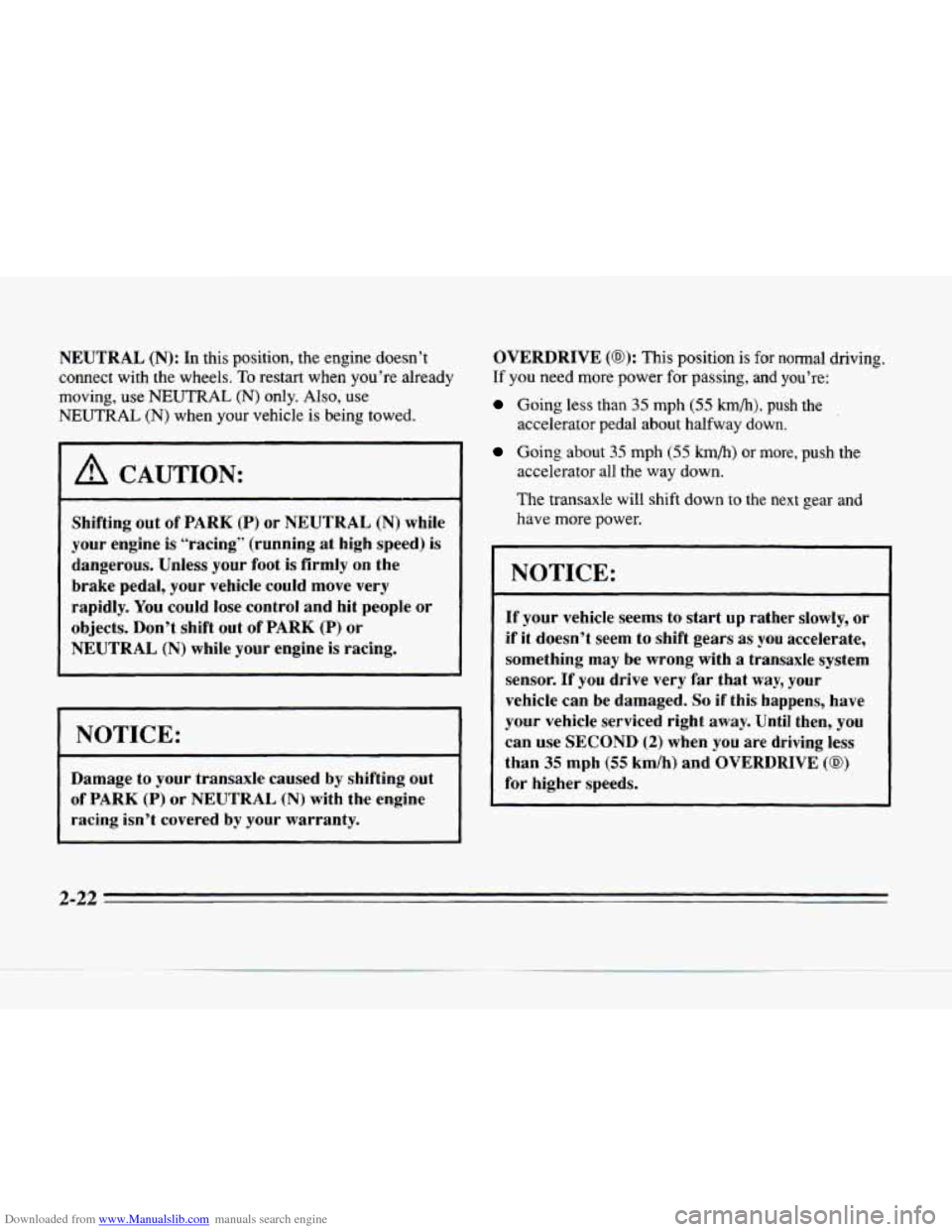
Downloaded from www.Manualslib.com manuals search engine NEUTRAL (N): In this position, the engine doesn’t
connect with the wheels.
To restart when you’re already
moving, use
NEUTRAL (N) only. Also, use
NEUTRAL (N) when your vehicle is being towed.
~~ ~
A CAUTION:
Shifting out of PARK (P) or NEUTRAL (N) while
your engine is “racing” (running at high speed) is
dangerous. Unless your foot is firmly on
the
brake pedal, your vehicle could move very
rapidly.
You could lose control and hit people or
objects. Don’t shift out of PARK
(P) or
NEUTRAL
(N) while your engine is racing.
I NOTICE:
Damage to your transaxle caused by shifting out
of
PARK (P) or NEUTRAL (N) with the engine
racing isn’t covered by your warranty. OVERDRIVE
(@): This position
is for normal driving.
If you need more power for passing, and you’re:
Going less than 35 mph (55 km/h), push the
accelerator pedal about halfway down.
Going about 35 mph (55 km/h) or more, push the
accelerator all the way down.
The transaxle
will shift down to the next gear and
have more power.
NOTICE:
If your vehicle seems to start up rather slowly, or
if it doesn’t seem to shift gears as you accelerate,
something may be wrong with a transaxle system
sensor. If
you drive very far that way, your
vehicle can be damaged.
So if this happens, have
your vehicle serviced right away. Until then, you
can use SECOND
(2) when you are driving less
than
35 mph (55 km/h) and OVERDRIVE (0)
for higher speeds.
c-
2-22
Page 82 of 354
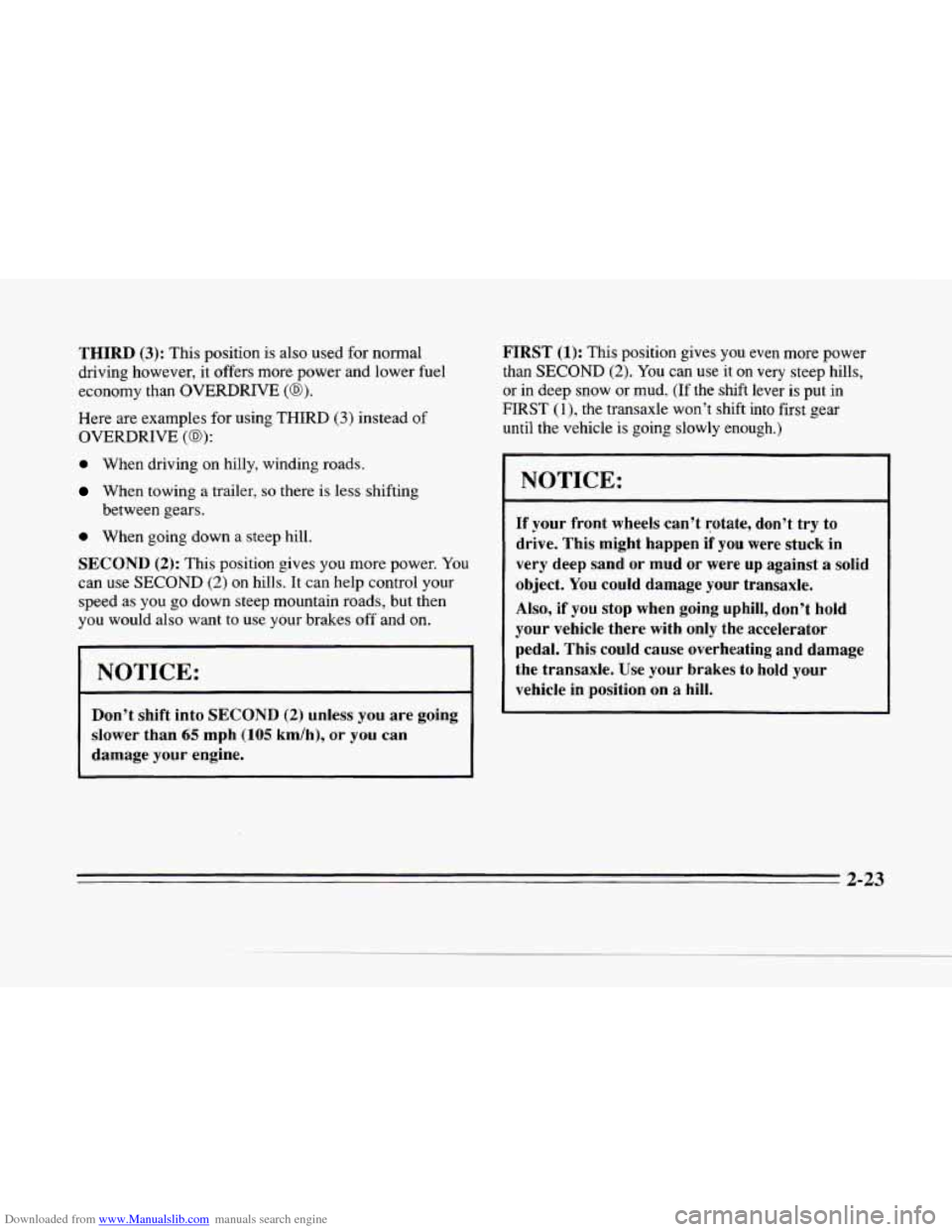
Downloaded from www.Manualslib.com manuals search engine r..
L
THIRD (3): This position is also used for normal
driving however, it offers more power and lower fuel
economy than OVERDRIVE
(@).
Here are examples for using THIRD (3) instead of
OVERDRIVE (a):
0 When driving on hilly, winding roads.
When towing a trailer, so there is less shifting
between gears.
0 When going down a steep hill.
SECOND (2): This position gives you more power. You
can use SECOND
(2) on hills. It can help control your
speed as
you go down steep mountain roads, but then
you would also want to use your brakes
off and on.
I NOTICE:
r
~~
Don’t shift into SECOND (2) unless you are going
slower than
65 mph (105 km/h), or you can
damage your engine. FIRST
(1): This
position gives you even more power
than SECOND
(2). You can use it on very steep hills,
or in deep snow or mud. (If the shift lever is put in
FIRST (l), the transaxle won’t shift into first gear
until the vehicle is going slowly enough.)
NOTICE:
If your front wheels can’t rotate, don’t try to
drive. This might happen if you were stuck in
very deep sand or mud or were
up against a solid
object.
You could damage your transaxle.
Also, if you stop when going uphill, don’t hold
your vehicle there with only the accelerator
pedal. This could cause overheating and damage
the transaxle.
Use your brakes to hold your
vehicle in position on
a hill.
2-23
Page 91 of 354
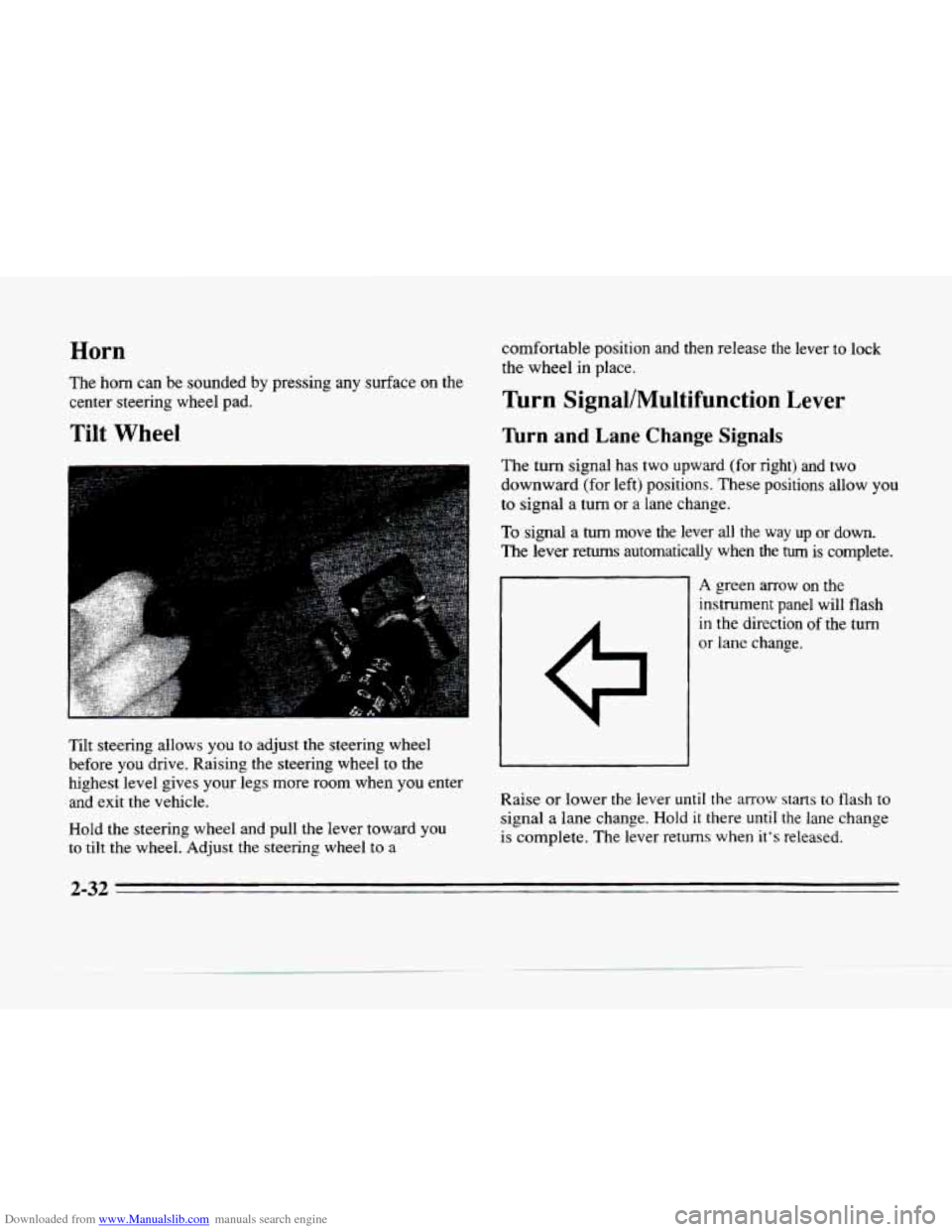
Downloaded from www.Manualslib.com manuals search engine Horn
The horn can be sounded by pressing any surface on the
center steering wheel pad.
Tilt Wheel
Tilt steering allows you to adjust the steering wheel
before
you drive. Raising the steering wheel to the
highest level gives your legs more room when you enter
and exit the vehicle.
Hold the steering wheel and pull the lever toward you
to tilt the wheel. Adjust the steering wheel to a
comfortable position and then release the lever to lock
the wheel in place.
Turn Signal/Multifunction Lever
Turn and Lane Change Signals
The turn signal has two upward (for right) and two
downward (for left) positions. These positions allow you
to signal
a turn or a lane change.
To signal a turn move the lever all the way up or down.
The lever returns automatically when the turn is complete.
A green arrow on the
instrument panel will flash
in the direction of the turn
or lane change.
Raise or lower the lever
until the arrow starts to flash to
signal a lane change. Hold it there until the lane change
is complete. The lever returns when it's released.
2-32
Page 96 of 354
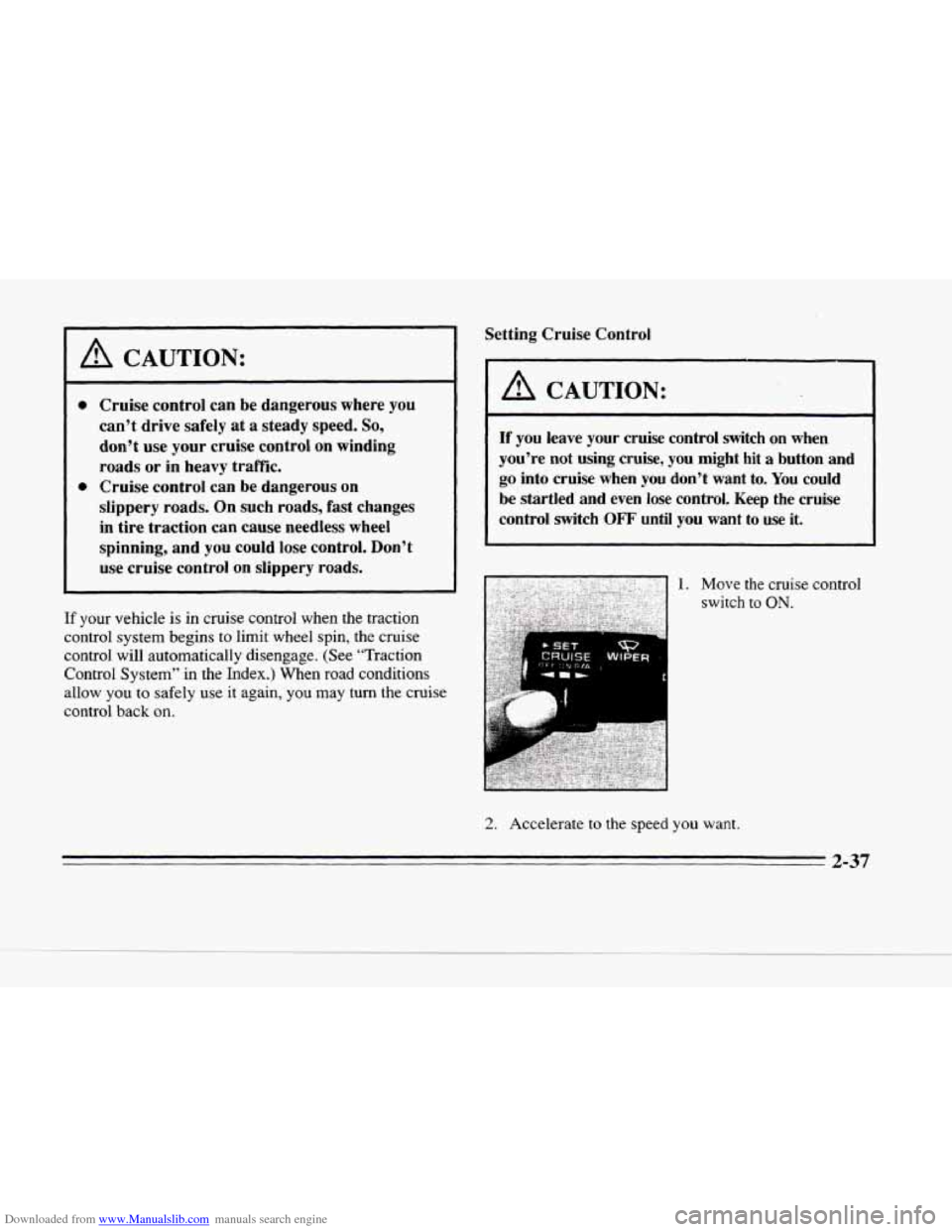
Downloaded from www.Manualslib.com manuals search engine h
A CAUTION:
Cruise control can be dangerous where you
can’t drive safely at
a steady speed. So,
don’t use your cruise control on winding
roads or
in heavy traffic.
Cruise control can
be dangerous on
slippery roads. On such roads, fast changes in tire traction can cause needless wheel
spinning, and you could lose control. Don’t
use cruise control on slippery roads.
If your vehicle is in cruise control when the traction
control system begins to limit wheel spin, the cruise
control will automatically disengage. (See “Traction
Control System” in the Index.) When road conditions
allow you
to safely use it again, you may turn the cruise
control back
on.
Setting Cruise Control
A CAUTION:
If you leave your cruise control switch on when
you’re not using cruise,
you might hit a button and
go into cruise when you don’t want to. You could
be startled and even lose control.
Keep the cruise
control switch
OFF until you want to use it.
n ‘ .,...., -
1. Move the cruise control
switch to ON.
2. Accelerate to the speed you want.
2-37
Page 114 of 354
Downloaded from www.Manualslib.com manuals search engine e
Illuminated Visor Vanity Mirror
Turn the sunshade down and lift the cover to see the
mirror. Move the slide switch up or down
to brighten or
dim the lamp.
Cellular Telephone (Option)
Your vehicle has been prewired for dealer installation
of a Cadillac dual-mode (analogRDMA) cellular
telephone.
A fixed mobile or a portable hand-held
system may be available for purchase. Either system
will have steering wheel telephone controls and will
have information output through the
DIC. Voice
activation and hands-free operation are standard
features. For more information, contact your Cadillac
dealer.
A user's guide is provided with the telephone.
Assist Handles
A folding handle above each rear door can be used when
getting out
of your vehicle.
Floor Mats
Your Cadillac is equipped with rubber-backed front and
rear floor mats. Keep them clean by vacuuming and
using a spot cleaner,
if necessary. Do not machine wash.
2-55
Page 120 of 354
Downloaded from www.Manualslib.com manuals search engine c
The instrument panel is designed to let you know at a
glance how your Cadillac is running. You’ll
know how
fast you’re going, how much fuel you’re using and
many
of the other things you’ll need to know to drive
safely and economically. The main components
of the
instrument panel are:
1. Air Outlets
[Wb
2. Turn Signal/Multifunction Lever
3. Driver Information Center Control Buttons
4. Driver’s Side Air Bag
5. Cluster
6. Steering Column Shift Lever
7.
8.
9.
10.
11.
12.
13.
14.
15.
16.
Electronic Climate Controls
Audio System
Passenger’s Side
Air Bag
Lamp Controls Steering Wheel Touch Controls for Climate Control
Hood Release
Horn
Steering Wheel Touch Controls for Audio System
Astray and Cigarette Lighter
Glove
Box
2-61